Part 1: Essential Ingredients for Your Perfect Marinara Sauce Recipe
Marinara sauce is a classic Italian favorite, made with simple, fresh ingredients. It’s perfect for pasta, pizza, and dipping breadsticks. In this part, we will dive into the essential ingredients you’ll need to create the perfect marinara sauce recipe. These ingredients are the foundation of the sauce and will ensure it has that bold, rich flavor we all love.
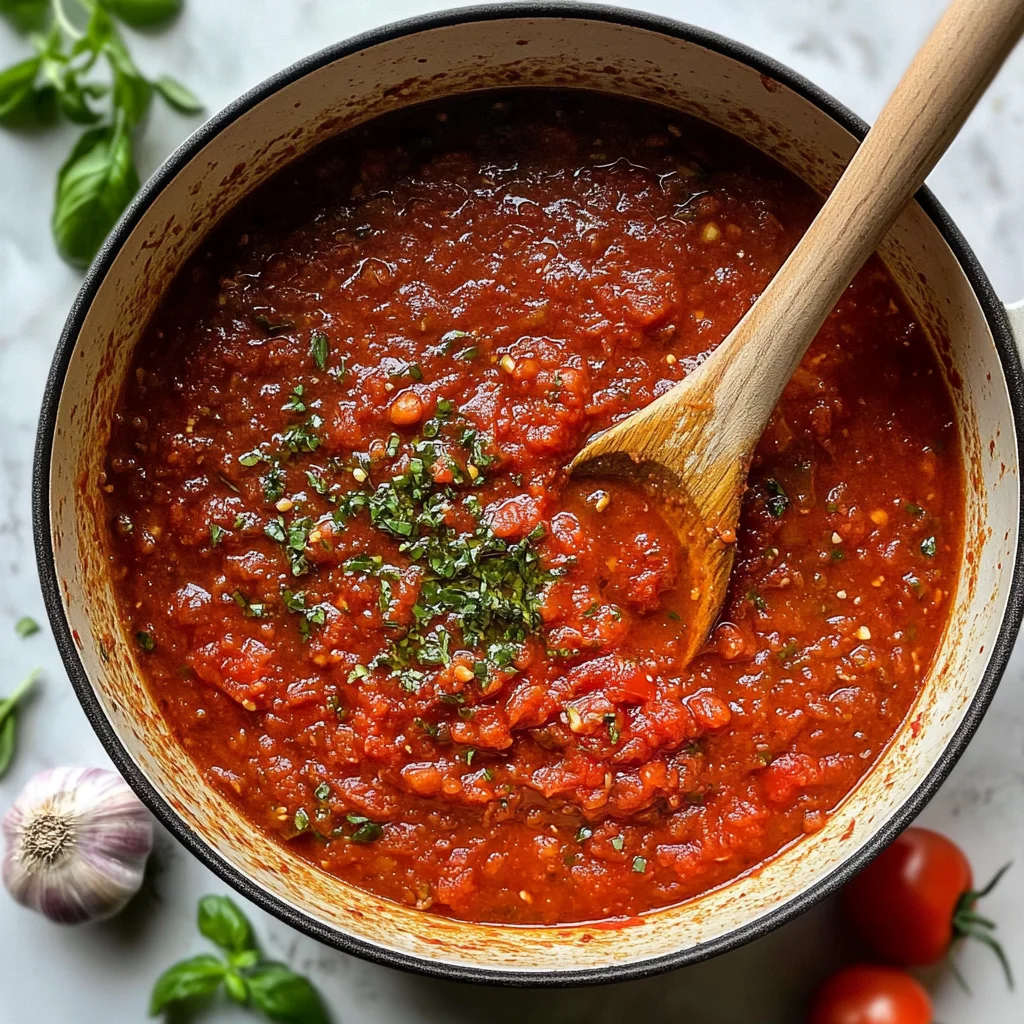
The Key Ingredients for Marinara Sauce
To make marinara sauce, you don’t need anything fancy. It’s all about using the freshest ingredients you can find. Here’s a breakdown of the key ingredients that make this sauce irresistible:
1. Tomatoes – The Heart of the Sauce
The star of any marinara sauce is, of course, the tomatoes. Fresh tomatoes are ideal for an authentic marinara, but canned San Marzano tomatoes are often used for their sweet, rich flavor. They’re especially popular because of their lower acidity. For a classic marinara, you need about 2 pounds of tomatoes. If you’re using fresh tomatoes, be sure to peel and chop them before adding them to the pan.
2. Garlic – The Aromatic Flavor Bomb
Garlic is a crucial part of marinara sauce. It adds that signature Italian flavor that is both savory and aromatic. You’ll want about 4 cloves of garlic, finely minced. When you sauté it in olive oil, the garlic will release a wonderful fragrance that makes your kitchen smell amazing. Just be careful not to overcook it, as burnt garlic can give your sauce a bitter taste.
3. Olive Oil – A Smooth Base
Olive oil is essential for making marinara sauce, as it adds richness and helps bring all the flavors together. The best choice is extra virgin olive oil, which is full of flavor and has a light, fruity taste. You’ll need about 2 tablespoons of olive oil for sautéing the garlic and cooking the sauce. It also helps reduce the acidity of the tomatoes.
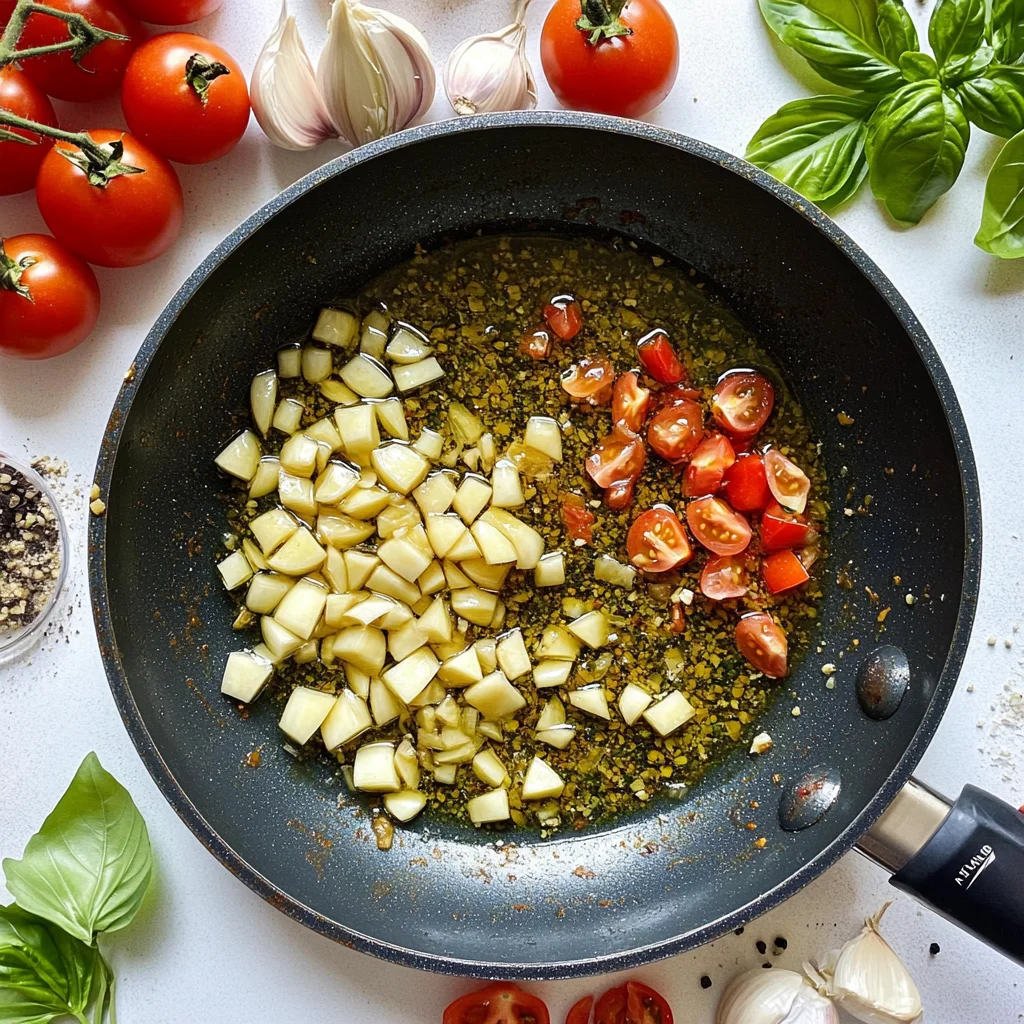
4. Fresh Herbs – Adding Depth to the Flavor
Fresh basil is a must for marinara sauce. It gives the sauce a sweet, slightly peppery flavor. You’ll also want to include a teaspoon of dried oregano for an authentic Italian touch. Some people like to add thyme or bay leaves to bring extra flavor. Fresh herbs should be added at the end of cooking to preserve their bright, aromatic taste.
Detailed List of Ingredients
To make your marinara sauce, gather the following ingredients:
- 2 pounds of San Marzano tomatoes (or 6 cups of fresh tomatoes, peeled and chopped)
- 4 cloves of garlic, finely minced
- 2 tablespoons of extra virgin olive oil
- 1 teaspoon of dried oregano
- 1 teaspoon of dried thyme (optional)
- 1-2 bay leaves (optional)
- A handful of fresh basil leaves, torn
- Salt and pepper to taste
Step-by-Step Cooking Instructions
- Prepare the Ingredients: Start by peeling and chopping your tomatoes if using fresh ones. Mince the garlic and tear the basil leaves into small pieces. This ensures everything is ready when you start cooking.
- Sauté the Garlic: Heat the olive oil in a large saucepan over medium heat. Add the minced garlic and sauté for about 1 minute, just until it becomes fragrant. Be sure to stir constantly to avoid burning it.
- Add the Tomatoes: Once the garlic is ready, add the chopped tomatoes (or crushed San Marzano tomatoes) to the pan. Stir to combine with the garlic. Let the mixture come to a simmer.
- Season the Sauce: Add the dried oregano, thyme, and bay leaves (if using). Stir in salt and pepper to taste. Reduce the heat and allow the sauce to simmer for 20-30 minutes, stirring occasionally. The sauce will thicken as it cooks.
- Finish the Sauce: Just before serving, remove the bay leaves and stir in the fresh basil. Taste the sauce and adjust the seasoning if needed. If it’s too acidic, you can add a pinch of sugar to balance it out.
Part 2: How to Adjust Your Marinara Sauce for Different Tastes
Making the perfect marinara sauce doesn’t just end with following the basic recipe. In this part, we’ll explore how you can adjust your marinara sauce to suit different flavor profiles. Whether you like it spicier, sweeter, or more savory, these tips will help you create a marinara sauce that’s tailored to your preferences.
1. Spicy Marinara Sauce
If you love a little heat, adding spice to your marinara sauce is a great way to kick things up a notch. Here’s how you can make a spicy marinara sauce:
- Add Red Pepper Flakes: Start with 1/2 teaspoon of red pepper flakes and increase based on your spice tolerance. Add them to the sauce when you add the oregano and thyme.
- Fresh Chilies: If you prefer fresh heat, finely chop 1-2 fresh chili peppers (like jalapeños or serranos) and sauté them with the garlic at the beginning.
- Hot Sauce: A dash of your favorite hot sauce can also give the sauce a nice kick. Add it towards the end, tasting as you go.
The spicy marinara sauce works great with pizza, pasta, or even as a dip for mozzarella sticks!
2. Sweet Marinara Sauce
Some people enjoy their marinara sauce with a touch of sweetness. To make your marinara sauce sweeter, here’s what you can do:
- Add Sugar: The simplest way to sweeten the sauce is by adding a small pinch of sugar—about 1 teaspoon. It will help balance the acidity of the tomatoes without overwhelming the flavor.
- Caramelized Onions: For a more natural sweetness, caramelize onions and add them to the sauce. The sugars in the onions will release as they cook, giving your marinara a mild sweetness that complements the tomatoes perfectly.
- Roasted Tomatoes: If you’re using fresh tomatoes, try roasting them first to bring out their natural sugars. Roasting intensifies their flavor, and your sauce will taste sweeter without adding extra sugar.
This sweeter version of marinara sauce works wonderfully for dishes like sweet Italian sausage pasta or a vegetable lasagna.
3. Savory Marinara Sauce
For those who prefer a more savory marinara sauce with deeper flavors, here are some tips to make your sauce less sweet and more robust:
- Add More Garlic and Herbs: If you want a bolder, more savory flavor, increase the amount of garlic. You can also add more herbs like rosemary or sage to bring out an earthy depth.
- Use Onion and Mushrooms: Sauté finely chopped onions and mushrooms along with the garlic for a savory, umami-packed sauce. Mushrooms will enhance the flavor of the sauce, making it richer and more complex.
- Add Parmesan Rind: Adding a Parmesan rind to the sauce while it simmers will infuse it with a deep, savory, and slightly nutty flavor. Just be sure to remove the rind before serving.
A savory marinara sauce is ideal for eggplant Parmesan or a hearty meatball sub.
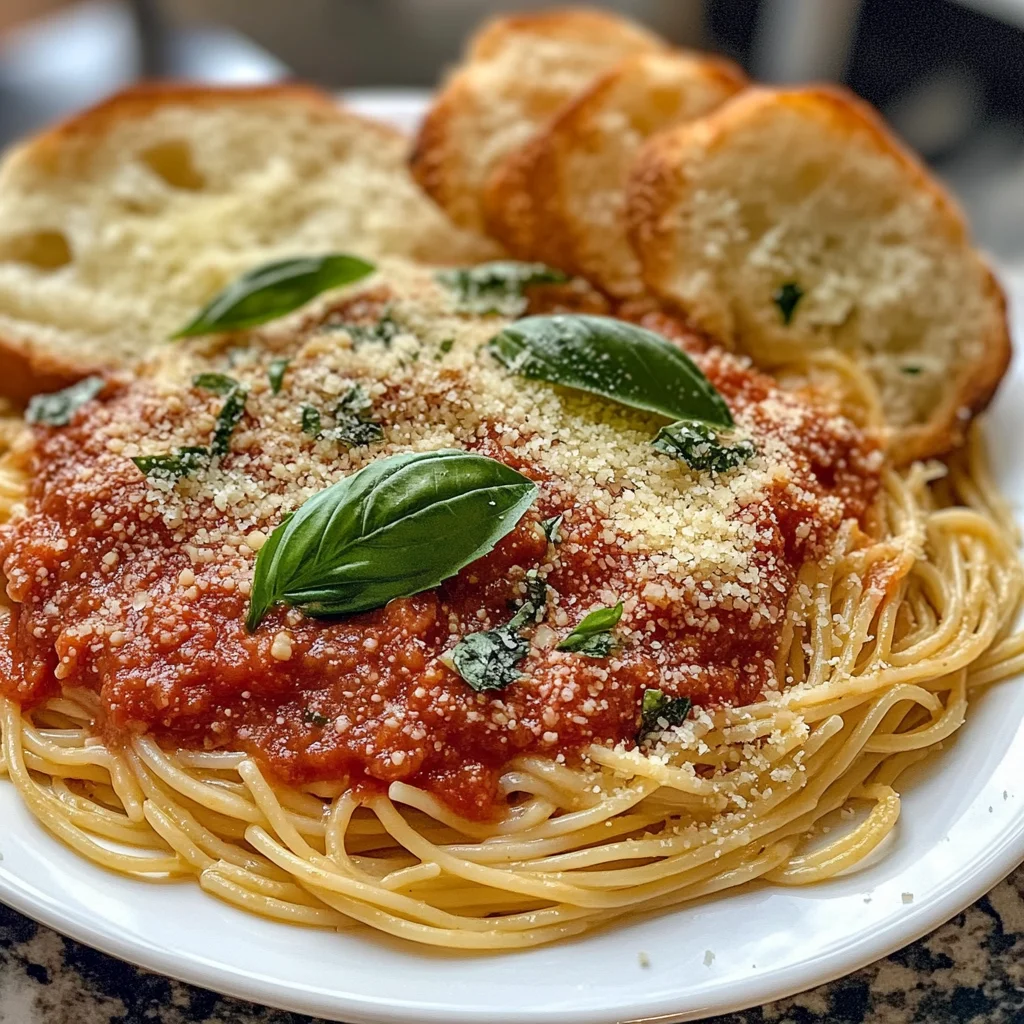
4. Vegetarian and Vegan Marinara Sauce
For those following a vegetarian or vegan lifestyle, marinara sauce is a great option. Luckily, it’s already mostly plant-based! However, you may want to make sure that all the ingredients are vegan-friendly. Here’s how:
- Olive Oil: Make sure to use extra virgin olive oil, which is naturally vegan. It’s a crucial part of marinara and helps enhance the sauce’s flavor.
- No Parmesan Cheese: Traditionally, marinara sauce can be topped with Parmesan cheese, but for a vegan version, simply omit this or replace it with a vegan cheese alternative.
- Vegetable Broth (Optional): If you prefer to reduce the amount of oil in your marinara sauce, you can sauté the garlic in vegetable broth instead of olive oil for a lighter sauce.
A vegan marinara sauce pairs wonderfully with zucchini noodles or vegan meatballs.
5. Thick vs. Thin Marinara Sauce
Depending on how you plan to use your marinara sauce, you may want to adjust its consistency. Here’s how to make it either thicker or thinner:
- For a Thick Sauce: Let the sauce simmer longer to reduce and thicken. You can also add a spoonful of tomato paste for a richer consistency. If the sauce is still too thin, add a bit more crushed tomatoes and cook until it thickens to your desired texture.
- For a Thin Sauce: If you prefer a thinner marinara sauce, add a small amount of water or vegetable broth as it simmers. You can also use fresh tomatoes, which have more liquid than canned ones.
A thicker marinara sauce works well for pizza or as a topping for baked pasta dishes, while a thinner sauce is great for serving over spaghetti or using as a dip.
Part 3: Serving Ideas and Pairings for Marinara Sauce
Now that you have your marinara sauce prepared and adjusted to your taste, it’s time to explore some delicious ways to serve it! Marinara sauce is incredibly versatile and can be used in so many dishes. In this part, we’ll discuss different ways to serve marinara sauce and give you ideas for pairing it with your favorite foods.
1. Classic Spaghetti Marinara
One of the most popular ways to enjoy marinara sauce is with pasta. Spaghetti marinara is a timeless Italian dish that’s simple to make and delicious every time.
- Cooking the Pasta: Start by cooking the spaghetti in a large pot of salted boiling water. Follow the package instructions, but aim to cook it al dente for the best texture.
- Tossing the Sauce: Once the pasta is ready, drain it and return it to the pot. Pour your marinara sauce over the pasta and toss until it’s fully coated.
- Topping it Off: For extra flavor, top the dish with freshly grated Parmesan cheese (or a vegan alternative) and a sprinkle of fresh basil leaves. You can also add a drizzle of extra virgin olive oil to enhance the flavor.
This classic dish is perfect for a quick, satisfying meal.
2. Marinara Sauce for Pizza
Marinara sauce is also a fantastic pizza sauce! Whether you’re making homemade pizza or using store-bought dough, marinara sauce adds that essential Italian flavor to every bite.
- Spread it Evenly: Roll out your pizza dough and spread a generous amount of marinara sauce on top, leaving a border around the edges for the crust.
- Add Toppings: Layer your favorite toppings on top, such as fresh mozzarella, basil, mushrooms, or even veggies. You can also sprinkle some red pepper flakes for a bit of heat.
- Bake the Pizza: Once your toppings are in place, bake the pizza in a preheated oven (usually 475°F or 245°C) for 10-12 minutes, or until the crust is golden brown and the cheese is bubbly.
A pizza with marinara sauce is always a hit at family dinners or parties.
3. Dipping Sauce for Breadsticks or Mozzarella Sticks
Marinara sauce also makes a perfect dipping sauce for breadsticks or mozzarella sticks. Whether you’re serving them as an appetizer or a snack, this combination is a crowd-pleaser.
- Serve Warm: Warm the marinara sauce in a saucepan or microwave and serve it alongside freshly baked breadsticks or crispy mozzarella sticks.
- Extra Toppings: If you like, sprinkle some Parmesan cheese on the breadsticks for added flavor or top your mozzarella sticks with fresh basil before serving.
This is a great option for parties or movie nights.
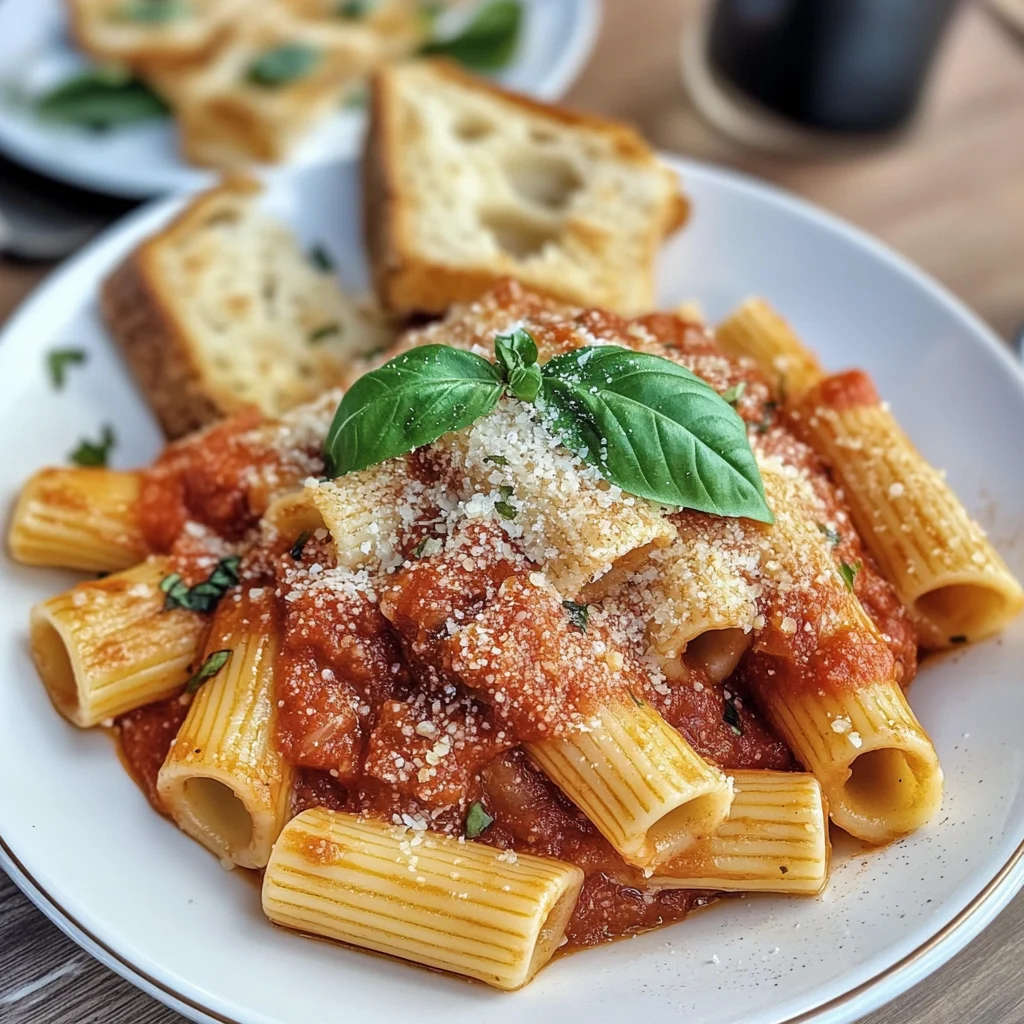
4. Meatballs with Marinara Sauce
Another classic pairing is marinara sauce with meatballs. Whether you’re making beef, turkey, or veggie meatballs, the rich flavor of marinara sauce complements the meat perfectly.
- Simmer the Meatballs: After cooking the meatballs, place them in a pot with marinara sauce and let them simmer for 15-20 minutes. This allows the meatballs to soak up the sauce and become extra flavorful.
- Serving the Meatballs: Serve the meatballs over a bed of pasta or on a sandwich roll for a hearty meatball sub. For a complete meal, add a side of steamed vegetables or a green salad.
This hearty dish is perfect for a filling dinner.
5. Baked Dishes with Marinara Sauce
Marinara sauce is also an excellent choice for baked dishes like lasagna or baked ziti. These hearty, comforting meals are filled with flavor and are great for feeding a crowd.
- Lasagna: Layer marinara sauce with sheets of pasta, ricotta cheese, and mozzarella. Repeat the layers, ending with a generous amount of marinara sauce on top. Bake until golden and bubbly.
- Baked Ziti: Toss cooked ziti pasta with marinara sauce, ricotta cheese, and mozzarella. Transfer it to a baking dish and bake until the cheese is melted and golden.
Both of these baked dishes are crowd favorites and are perfect for family dinners or special occasions.
6. Marinara Sauce for Grilled Vegetables
If you’re looking for a lighter option, marinara sauce can be used as a topping for grilled vegetables. The rich, tangy sauce pairs perfectly with the smoky flavors of grilled zucchini, eggplant, and bell peppers.
- Grill the Vegetables: Toss the vegetables in olive oil, salt, and pepper, then grill them until they’re tender and have nice grill marks.
- Serve with Marinara Sauce: Once the vegetables are grilled, serve them with a side of marinara sauce for dipping or spoon the sauce over the top.
This makes for a healthy and flavorful side dish or light meal.
Part 4: Storing and Preserving Marinara Sauce for Later Use
Making marinara sauce in bulk is a great way to have it on hand whenever you need it. Properly storing and preserving your marinara sauce ensures that you can enjoy the flavors for weeks or even months. In this section, we’ll explore different methods for storing marinara sauce, how to freeze it, and how to reheat it without losing its quality.
1. How to Store Marinara Sauce in the Refrigerator
If you’ve made a big batch of marinara sauce and plan to use it within the next few days, storing it in the refrigerator is a simple and effective option. Here’s how to do it properly:
- Cool the Sauce: Before storing the sauce, let it cool to room temperature. This prevents condensation inside the storage container, which can affect the texture and flavor.
- Store in an Airtight Container: Transfer the sauce into an airtight container, which helps prevent oxidation and keeps the sauce fresh. You can store it in glass jars, plastic containers, or even freezer-safe bags if you want to save space.
- Shelf Life: When stored properly in the fridge, marinara sauce typically lasts for about 4-7 days. Be sure to check for signs of spoilage, such as an off smell or mold growth.
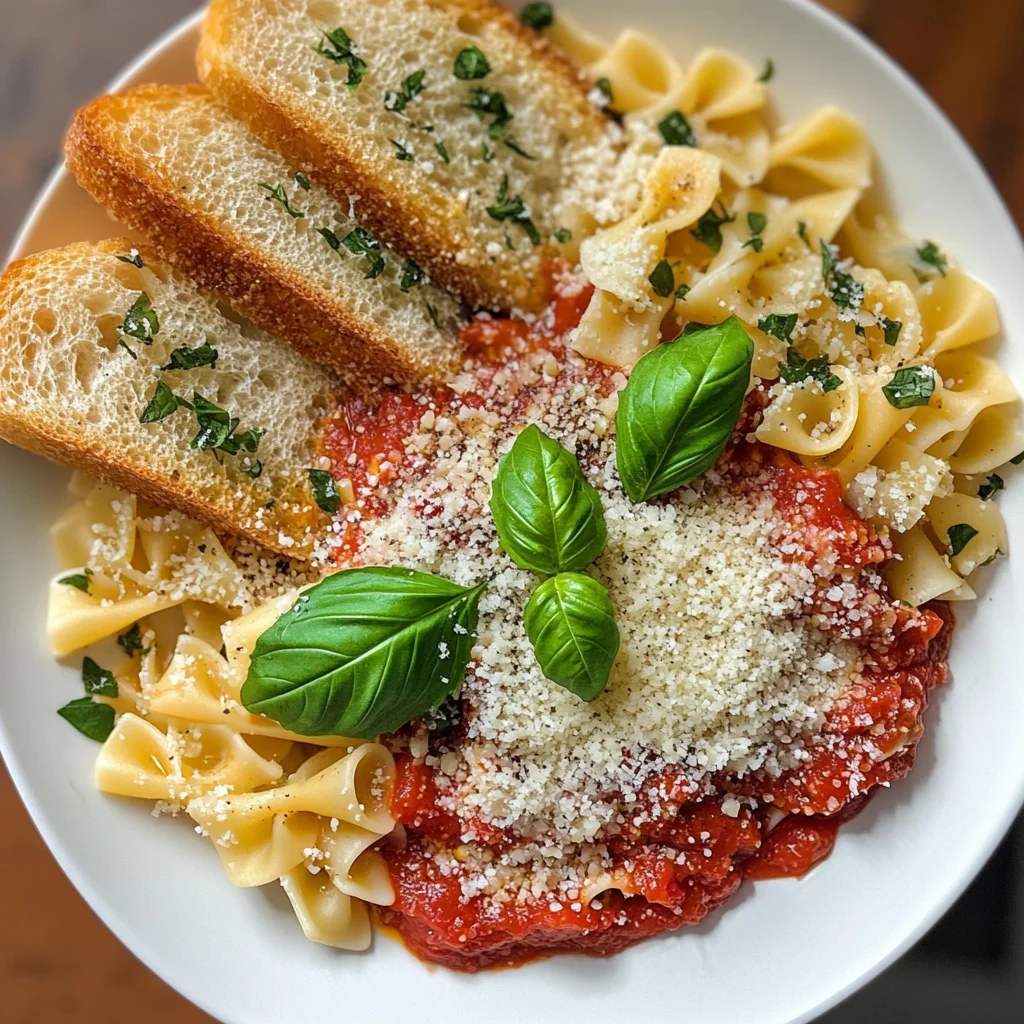
2. Freezing Marinara Sauce for Long-Term Storage
Freezing marinara sauce is an excellent way to preserve it for long-term use. If you’ve made a large batch and want to save some for later, freezing is your best bet. Here’s how to do it:
- Cool the Sauce First: Allow the sauce to cool completely before freezing. This ensures it freezes evenly and prevents ice crystals from forming.
- Portion It Out: To make defrosting easier, consider portioning the sauce into smaller servings. Use freezer-safe containers, zip-top bags, or even ice cube trays for individual portions. If you use bags, try to squeeze out as much air as possible to prevent freezer burn.
- Label and Date: Be sure to label your containers with the date so you can keep track of how long it’s been stored. Marinara sauce can be frozen for up to 3 months.
- Reheating from Frozen: When you’re ready to use the sauce, you can either thaw it in the fridge overnight or reheat it straight from the freezer. If reheating from frozen, do so over low heat, stirring occasionally, until the sauce is fully thawed and heated through.
3. How to Store Marinara Sauce in Canning Jars
Canning marinara sauce is another great option for long-term storage, especially if you’ve made a large batch and want to preserve it for the year ahead. Canning allows you to store the sauce safely at room temperature. Here’s how to do it:
- Sterilize the Jars: Before canning, sterilize your jars and lids by boiling them in water for 10-15 minutes. This helps to prevent any bacteria from contaminating your sauce.
- Fill the Jars: While the sauce is still hot, carefully ladle it into the sterilized jars, leaving about 1-inch of headspace at the top. Wipe the rims of the jars to ensure they’re clean before sealing with the lids.
- Process the Jars: To ensure the sauce is sealed properly, process the jars in a water bath canner for about 35 minutes. This will help the jars form a vacuum seal, which keeps the sauce fresh.
- Cool and Store: Let the jars cool completely at room temperature. Once cooled, store them in a cool, dark place such as a pantry. Properly canned marinara sauce can last up to a year.
4. How to Tell When Marinara Sauce Has Gone Bad
It’s important to check the condition of your marinara sauce before using it, especially if it’s been sitting in your fridge or freezer for a while. Here are some signs that your marinara sauce may have gone bad:
- Smell: If the sauce smells sour, rancid, or off, it’s best to discard it.
- Color Change: While some color changes may happen naturally, if the sauce turns a dark, brownish color, it could indicate spoilage.
- Mold: Any signs of mold on the surface mean the sauce should be thrown away immediately.
- Texture: If the sauce becomes overly watery or separated, it may not be safe to eat.
Always trust your senses when it comes to food safety.
5. Reheating Tips for Marinara Sauce
Once your marinara sauce is stored, it’s essential to reheat it properly to preserve its flavor and consistency. Here’s how:
- On the Stovetop: Place the sauce in a saucepan over low to medium heat. Stir occasionally to ensure even heating. If the sauce is too thick, add a splash of water, vegetable broth, or even a bit more olive oil to adjust the consistency.
- In the Microwave: You can also reheat marinara sauce in the microwave. Transfer it to a microwave-safe container, cover with a microwave-safe lid or paper towel, and heat in 30-second intervals, stirring in between.
- Avoid Boiling: When reheating, avoid bringing the sauce to a boil as it can affect the texture. Gently simmer or warm it for the best results.
Part 5: Common Marinara Sauce Mistakes to Avoid
While making marinara sauce is relatively simple, there are a few common mistakes that can affect the flavor and texture of your sauce. In this section, we’ll go over some of the most frequent issues people encounter when making marinara sauce and offer tips on how to avoid them.
1. Using Poor-Quality Tomatoes
The quality of your tomatoes can make or break your marinara sauce. Many people make the mistake of using low-quality, canned tomatoes, which can result in a bland or overly acidic sauce.
- Choose High-Quality Tomatoes: Always use ripe, flavorful tomatoes for the best results. If using canned tomatoes, opt for high-quality brands like San Marzano, known for their rich flavor and low acidity. These tomatoes are ideal for creating a rich, balanced marinara sauce.
- Fresh vs. Canned: If using fresh tomatoes, select plum or Roma tomatoes, as they have fewer seeds and a meatier texture, which creates a smoother sauce. However, canned tomatoes can also produce an excellent sauce when fresh tomatoes aren’t in season.
2. Not Allowing the Sauce to Simmer Long Enough
A mistake many people make is rushing the cooking process. Marinara sauce benefits from a long, slow simmer, which allows the flavors to meld and develop fully.
- Simmer the Sauce: Once you’ve added all the ingredients to the pot, let the sauce simmer over low heat for at least 30 minutes. This allows the tomatoes to break down and become rich, and it also helps the garlic and herbs to infuse the sauce.
- Taste and Adjust: As the sauce simmers, taste it periodically and adjust the seasoning if necessary. You may need to add a pinch of salt, a dash of pepper, or a little sugar to balance the acidity of the tomatoes.
3. Not Balancing Acidity
Tomatoes naturally have a high level of acidity, which can make the sauce taste tart or overly sharp if not balanced properly.
- Balance the Acidity with Sugar: A small amount of sugar (about 1 teaspoon) can help balance out the natural acidity in the tomatoes. Be careful not to add too much, as this can make the sauce too sweet.
- Add Baking Soda: If your sauce tastes too acidic even after adding sugar, try stirring in a pinch of baking soda. This will neutralize the acidity and smooth out the flavor.
- Use Sweet Ingredients: Adding vegetables like carrots or onions can also help to balance the acidity, as their natural sweetness will mellow the sharpness of the tomatoes.
4. Overcooking or Burning the Garlic
Garlic is a key ingredient in marinara sauce, but if it’s overcooked or burned, it can introduce a bitter flavor that ruins the sauce.
- Cook Garlic Gently: Always cook garlic over low to medium heat to avoid burning. Sauté it in olive oil until it’s fragrant, which usually takes about 1-2 minutes. Once it starts to brown, it’s time to add the tomatoes or other ingredients.
- Watch Closely: Garlic can burn very quickly, so keep a close eye on it and stir frequently to ensure it doesn’t brown too much. The goal is to release its flavor without turning it bitter.
5. Skipping the Fresh Herbs
Fresh herbs can elevate the flavor of your marinara sauce, but some people make the mistake of skipping them altogether or using dried herbs in large amounts.
- Use Fresh Herbs for Maximum Flavor: Fresh basil, oregano, and thyme can make a significant difference in the flavor of your marinara sauce. If you use dried herbs, reduce the amount by about half since they’re more concentrated.
- Add Fresh Herbs at the Right Time: Add fresh basil or oregano towards the end of the simmering process to preserve their bright, fresh flavor. If you add them too early, they can lose their potency.
6. Not Adjusting for Personal Preferences
One of the beauties of marinara sauce is that you can adjust it to suit your personal taste. Some people may like it spicier, while others prefer it sweeter or more savory. Not adjusting the sauce to your preferences is a missed opportunity!
- Taste as You Go: As your marinara sauce simmers, taste it and adjust the seasoning as needed. Add more salt, pepper, or red pepper flakes for extra heat. A bit of balsamic vinegar or a splash of red wine can add depth and complexity.
- Experiment with Add-Ins: Try adding vegetables like bell peppers, onions, or mushrooms for a unique twist. You can also add a splash of balsamic vinegar for a tangy sweetness, or a dash of red wine for a richer flavor profile.
7. Not Letting the Sauce Rest
After you’ve finished cooking your marinara sauce, it’s tempting to dive right in and serve it immediately. However, allowing the sauce to rest for a while can improve its flavor.
- Let the Sauce Sit: After cooking, let your marinara sauce sit for at least 15 minutes before serving. This resting time allows the flavors to meld together and gives the sauce time to thicken slightly.
- Reheat Gently: If you’ve made the sauce ahead of time, gently reheat it over low heat before serving. Stir occasionally to prevent it from sticking to the bottom of the pot.
Part 6: Creative Ways to Use Marinara Sauce Beyond Pasta and Pizza
While marinara sauce is most commonly paired with pasta and pizza, it’s a versatile ingredient that can enhance a variety of dishes. In this section, we’ll explore some creative ways to use marinara sauce that will elevate your meals and make the most out of your homemade sauce.
1. Marinara as a Dip for Breadsticks and Garlic Bread
Marinara sauce is the perfect dip for breadsticks or garlic bread, adding a tangy, savory touch to your appetizer. This simple pairing elevates your bread dishes and gives them an extra layer of flavor.
- For Breadsticks: Serve marinara sauce alongside warm, crispy breadsticks for a delightful snack or appetizer. The rich tomato sauce complements the buttery flavor of the breadsticks, making for a satisfying bite.
- For Garlic Bread: Dip slices of crispy, garlic-buttered bread into marinara for a delicious contrast between the garlicky crunch and the tangy sauce.
2. Use Marinara Sauce in Meatball Subs
Meatball subs are a classic sandwich made even better with marinara sauce. The juicy, savory meatballs paired with marinara sauce create a hearty and flavorful sandwich that’s perfect for lunch or dinner.
- Assembly: Place your cooked meatballs in a sub roll and smother them with marinara sauce. Top with melted mozzarella cheese and toast the sandwich for a deliciously melty treat.
- Customizable: Feel free to add other ingredients, like sautéed onions, bell peppers, or even a sprinkle of Parmesan for extra flavor.
3. Marinara Sauce as a Topping for Baked Chicken Parmesan
Chicken Parmesan is another dish that shines with marinara sauce. This classic comfort food is a crowd-pleaser and can easily be made at home with a few simple ingredients.
- Breaded Chicken: Start by breading and frying chicken breasts. Then, top them with marinara sauce and a generous amount of mozzarella cheese. Bake the chicken until the cheese is melted and bubbly.
- Serve with Pasta or Vegetables: Chicken Parmesan can be served over spaghetti, or for a low-carb option, over roasted vegetables like zucchini or eggplant.
4. Marinara Sauce in Stuffed Bell Peppers
Stuffed bell peppers are a delicious and nutritious way to use marinara sauce. The savory sauce pairs perfectly with the filling of seasoned meat, rice, and vegetables, creating a satisfying meal.
- Stuffing the Peppers: Hollow out bell peppers and fill them with a mixture of ground meat, cooked rice, onions, and seasonings. Pour marinara sauce over the stuffed peppers and bake until tender.
- Top with Cheese: For an extra layer of flavor, top the stuffed peppers with shredded mozzarella or Parmesan cheese and bake until melted.
5. Use Marinara Sauce for Shakshuka
Shakshuka is a Middle Eastern dish that features poached eggs in a flavorful tomato-based sauce. Marinara sauce makes an excellent base for shakshuka, adding richness and depth to the dish.
- Prepare the Sauce: Heat marinara sauce in a skillet and simmer until it’s slightly thickened. Create small wells in the sauce and crack eggs into them. Cover the skillet and let the eggs cook in the sauce until the whites are set but the yolks remain runny.
- Serve with Bread: Shakshuka is traditionally served with crusty bread, perfect for dipping into the rich tomato sauce and eggs.
6. Marinara Sauce as a Base for Soups and Stews
Marinara sauce can serve as the base for a variety of soups and stews, adding a rich, tomatoey flavor that enhances the dish. Whether you’re making a hearty vegetable soup or a meat-based stew, marinara can give your dish a flavorful start.
- In Vegetable Soup: Add marinara sauce to vegetable soup to create a rich and comforting base. You can also include beans, lentils, and pasta to make the soup heartier.
- In Stews: Marinara works wonderfully in meat-based stews, particularly beef or lamb. It adds a tangy depth to the broth and complements the other ingredients.
7. Marinara Sauce in Lasagna
Lasagna is another Italian classic that requires marinara sauce. This layered pasta dish is filled with cheese, meat, and marinara sauce, making it a filling and satisfying meal.
- Layering the Lasagna: Alternate layers of cooked pasta, ricotta cheese, mozzarella, and marinara sauce in a baking dish. Add your choice of cooked meat (such as ground beef or sausage) or even sautéed vegetables for a vegetarian version.
- Bake Until Bubbling: Bake the lasagna until it’s bubbly and golden, allowing the sauce to soak into the noodles and melt the cheese. This makes for a comforting and indulgent meal.
8. Marinara Sauce as a Topping for Grilled Vegetables
If you’re looking for a simple way to add extra flavor to your grilled vegetables, marinara sauce is the perfect topping. It enhances the smoky flavors of grilled vegetables and adds moisture to the dish.
- Grilled Veggies: Grill vegetables like zucchini, eggplant, or bell peppers until tender and slightly charred. Top with a spoonful of marinara sauce and serve as a side dish or main course.
- Add Parmesan: Sprinkle grated Parmesan over the grilled vegetables and sauce for an extra layer of flavor.
Part 7: Frequently Asked Questions About Marinara Sauce
Marinara sauce is a kitchen staple, but like many beloved recipes, it raises some common questions among home cooks. In this section, we’ll answer the most frequently asked questions about marinara sauce, from storing tips to variations and everything in between.
1. How long can you store homemade marinara sauce?
Homemade marinara sauce can last for up to 5 days when stored properly in an airtight container in the refrigerator. If you want to keep it longer, you can freeze the sauce for up to 3 months. Simply store the sauce in freezer-safe containers or freezer bags, and make sure to leave some space for the sauce to expand as it freezes.
- Refrigeration: Always allow your marinara sauce to cool completely before refrigerating it. This will help prevent condensation from forming inside the container, which can lead to spoilage.
- Freezing Tips: When freezing, portion out the sauce into small batches to make it easy to thaw only what you need. You can also freeze it in ice cube trays for smaller portions.
2. Can I make marinara sauce ahead of time?
Absolutely! Marinara sauce actually tastes better the next day as the flavors have more time to meld together. You can make it a day or two ahead of time, refrigerate it, and simply reheat when you’re ready to use it.
- Make It Ahead: If you’re planning for a busy week, making marinara sauce ahead of time is a great way to save time. You can use it for pasta, pizza, or any of the creative dishes we’ve discussed.
- Storage: As mentioned earlier, store it in an airtight container in the fridge for up to 5 days. You can also freeze it if you plan to use it in the future.
3. Can I use marinara sauce for pasta dishes other than spaghetti?
Yes! Marinara sauce is incredibly versatile and can be used for a variety of pasta dishes, not just spaghetti. Try using marinara sauce with rigatoni, penne, fusilli, or any other pasta shape that holds the sauce well.
- Pasta Alternatives: Marinara sauce can also be used for baked pasta dishes like lasagna, or served over stuffed pasta such as ravioli or tortellini. The rich, flavorful sauce complements all kinds of pasta.
- Vegetarian Options: You can use marinara sauce as a base for a variety of vegetarian pasta dishes, such as eggplant Parmesan or a pasta with sautéed vegetables and marinara.
4. Can I make marinara sauce spicier?
If you enjoy a little heat, you can definitely make your marinara sauce spicier. Add red pepper flakes or fresh chili peppers to the sauce during the simmering process to infuse it with extra heat.
- Red Pepper Flakes: Start with a small pinch of red pepper flakes and adjust based on your spice preference. The longer the sauce simmers, the more the heat will infuse into the sauce.
- Fresh Chilies: If you prefer fresh heat, add finely chopped fresh chili peppers like jalapeños or serranos to the sauce and cook them along with the garlic.
5. Can marinara sauce be used in non-Italian dishes?
Yes! Marinara sauce’s versatility extends far beyond traditional Italian recipes. You can use marinara sauce in a variety of cuisines to add a rich, savory tomato base.
- In Mexican Dishes: Use marinara sauce in dishes like enchiladas or as a base for a quick chili. It provides a flavorful, tangy kick that complements the spices in Mexican cuisine.
- In Middle Eastern Dishes: Marinara sauce can be used as a base for shakshuka, a popular dish of poached eggs in a spicy tomato sauce. It’s also great for stews and meatballs in a variety of international dishes.
6. Can I substitute marinara sauce for pizza sauce?
Yes, marinara sauce can be used as a pizza sauce, but it may be a little runnier than traditional pizza sauce. If you want a thicker consistency, simply simmer the marinara sauce longer to reduce it and thicken up the sauce.
- Thickening the Sauce: To make marinara sauce more like pizza sauce, you can add a small amount of tomato paste while it simmers to create a thicker texture.
- Flavor Adjustment: You may also want to adjust the seasoning slightly, as pizza sauce typically has a more concentrated flavor profile. Add a pinch of sugar, a dash of oregano, or extra garlic for more pizza-like flavor.
7. What can I add to marinara sauce to enhance the flavor?
To elevate your marinara sauce, there are several ingredients you can add to enhance the flavor profile.
- Fresh Herbs: Fresh basil, oregano, and thyme can add a burst of freshness. Stir these in towards the end of cooking to preserve their bright flavors.
- Parmesan Cheese: Adding a small amount of freshly grated Parmesan cheese to the sauce can make it richer and more savory.
- Balsamic Vinegar or Red Wine: A splash of balsamic vinegar or a bit of red wine can deepen the flavor and add complexity to your marinara sauce.

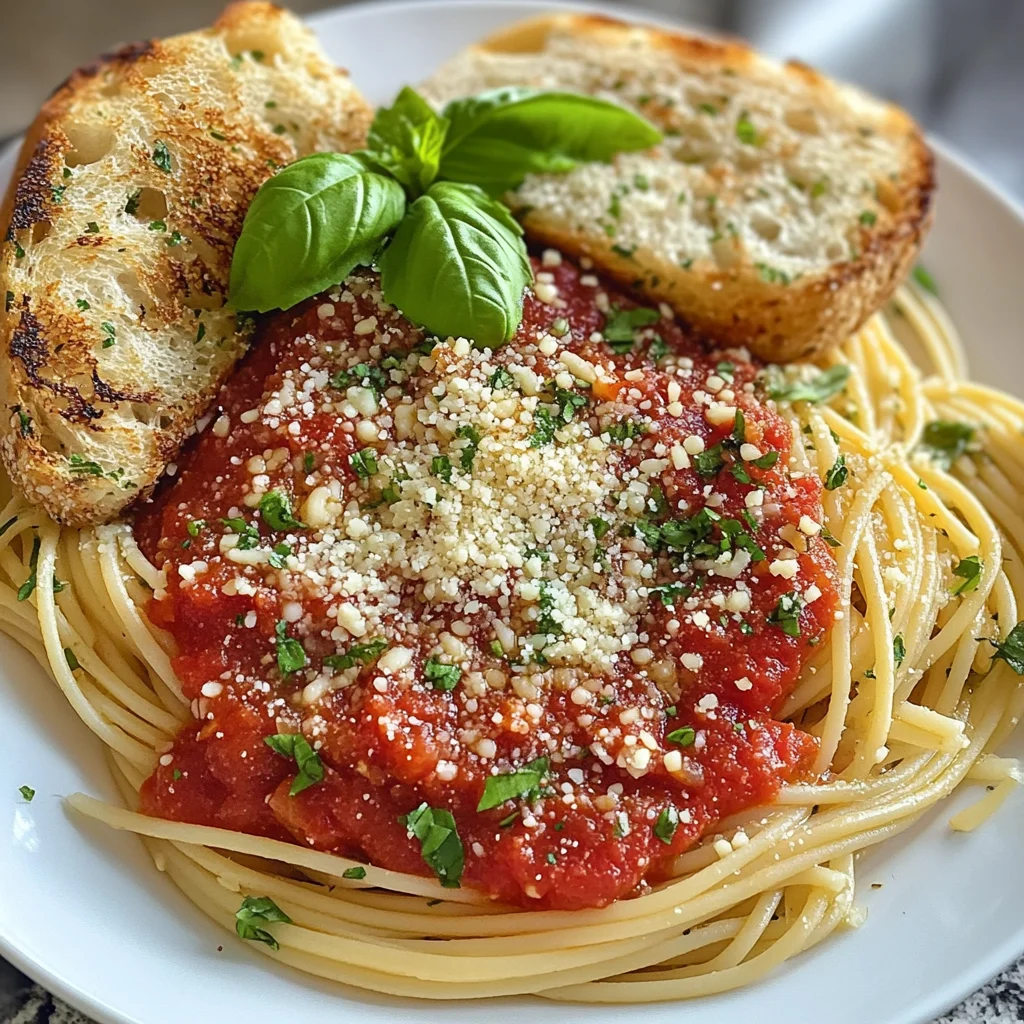
3 thoughts on “Marinara Sauce at Home”